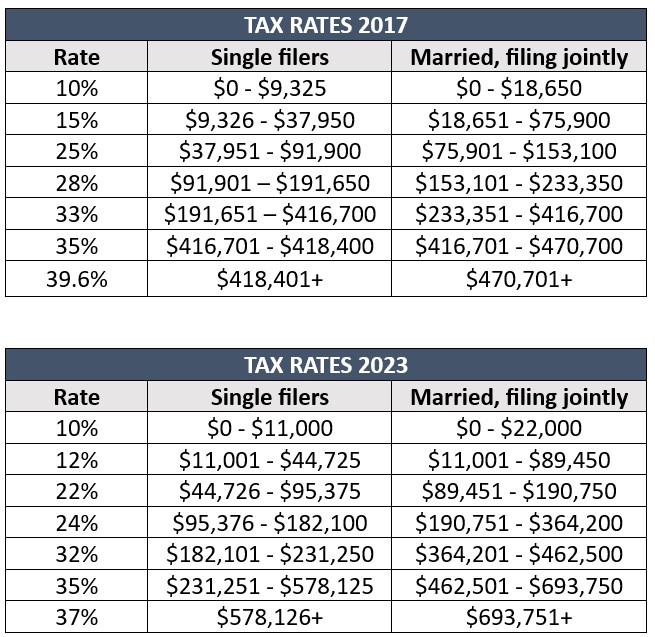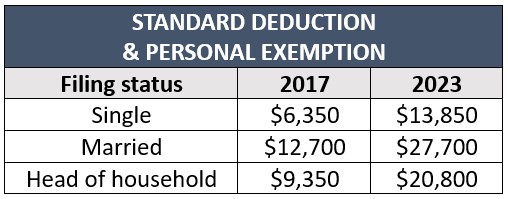What You Can Do Now to Avoid Paying Higher Taxes in 2026
Tax rates are set to increase once the Tax Cuts and Jobs Act sunsets at the end of 2025, but steps you take now could put you in a better financial position.


The Tax Cuts and Jobs Act of 2017 resulted in lower tax rates for Americans. The act is scheduled to expire at the end of 2025 — and when it does, tax rates will revert to 2017 levels unless Congress takes action before then.
The TCJA's sunset means the majority of Americans will see an increase in how much they owe in taxes. Take a look at how income tax brackets and rates compared in 2017 and 2023:

As you can see, if you are in the 12% bracket in 2023, you would fall into the 15% bracket with the same income once the TCJA expires. If you’re currently in the 22% bracket, you will move to the 25% bracket in 2026. And if you fall in the 24% bracket in 2023, you could jump to the 28% bracket when rates increase.
From just $107.88 $24.99 for Kiplinger Personal Finance
Become a smarter, better informed investor. Subscribe from just $107.88 $24.99, plus get up to 4 Special Issues

Sign up for Kiplinger’s Free Newsletters
Profit and prosper with the best of expert advice on investing, taxes, retirement, personal finance and more - straight to your e-mail.
Profit and prosper with the best of expert advice - straight to your e-mail.
Many Americans also benefited from an increase in the standard deduction amount, which doubled following the TCJA. Here’s how standard deductions and personal exemptions changed from 2017 to 2023:

The higher tax rates and expanded tax brackets plus a lower standard deduction mean many Americans could end up paying about 20% more in taxes when the TCJA expires. Here’s a breakdown of a real-life example of how much more one couple might end up paying in 2026 vs 2023:

I like to think of our current low-tax-rate environment as a “tax sale.” Just as we would stock up on items at the grocery store during a big sale, most of us would benefit from paying taxes now, rather than waiting until rates go up. If we don’t do it now, we may be forced to pay higher rates on distributions from tax-deferred investments like 401(k)s and IRAs in retirement.
We can take advantage of lower rates by implementing proactive tax planning strategies and be what I call “tax smart.” One way to do this is through a Roth IRA conversion, where money from tax-deferred accounts is moved to a Roth IRA account. You will pay taxes on the amount converted now, but you won’t pay taxes on withdrawals made later. This strategy could result in more money to live on in retirement.
At our firm, we’ve used this strategy with many of our clients, who often ask us, “Why didn’t my previous financial planner suggest a Roth IRA conversion earlier?” My answer is that many financial planners don’t specialize in tax planning. Instead, most focus only on investment management and not the other four pillars of a complete financial plan: taxes, estate planning, health care and income. I encourage you to find a team of financial planners who specialize in all five pillars to ensure you are getting the financial plan you deserve.
Interested in more information on the TCJA expiration or other tax planning strategies? Read my book, I Hate Taxes: Lower Your Taxes, Own Your Retirement, to learn more.
The appearances in Kiplinger were obtained through a public relations program. The columnist received assistance from a public relations firm in preparing this piece for submission to Kiplinger.com. Kiplinger was not compensated in any way.
Related Content
- Prepare for 2026 Estate Planning With SPATs, SLATs and DAPTs
- Don’t Let the 'Widow's Penalty' Blindside You: How to Prepare
- Are You Taking Too Much Risk in Retirement?
- High-Income Millennials, This Advice Is for You
- Will You Pay Higher Taxes in Retirement?
Profit and prosper with the best of Kiplinger's advice on investing, taxes, retirement, personal finance and much more. Delivered daily. Enter your email in the box and click Sign Me Up.

Joe F. Schmitz Jr., CFP®, ChFC®, CKA®, is the founder and CEO of Peak Retirement Planning, Inc., which was named the No. 1 fastest-growing private company in Columbus, Ohio, by Inc. 5000 in 2025. His firm focuses on serving those in the 2% Club by providing the 5 Pillars of Pension Planning. Known as a thought leader in the industry, he is featured in TV news segments and has written three bestselling books: I Hate Taxes (request a free copy), Midwestern Millionaire (request a free copy) and The 2% Club (request a free copy).
Investment Advisory Services and Insurance Services are offered through Peak Retirement Planning, Inc., a Securities and Exchange Commission registered investment adviser able to conduct advisory services where it is registered, exempt or excluded from registration.
-
 3 Ways to Stretch the 2026 Social Security COLA For Your Budget
3 Ways to Stretch the 2026 Social Security COLA For Your BudgetThree steps retirees can take to stretch the Social Security COLA to fit their budgets.
-
 How to Keep Your Charitable Giving Momentum Going All Year
How to Keep Your Charitable Giving Momentum Going All YearInstead of treating charity like a year-end rush for tax breaks, consider using smart tools like DAFs and recurring grants for maximum impact all the year.
-
 Uber Takes Aim at the Bottom Lines of Billboard Lawyers
Uber Takes Aim at the Bottom Lines of Billboard LawyersUber has filed lawsuits and proposed a ballot initiative, in California, to curb settlements it claims are falsely inflated by some personal injury lawyers.
-
 Giving Tuesday Is Just the Start: An Expert Guide to Keeping Your Charitable Giving Momentum Going All Year
Giving Tuesday Is Just the Start: An Expert Guide to Keeping Your Charitable Giving Momentum Going All YearInstead of treating charity like a year-end rush for tax breaks, consider using smart tools like DAFs and recurring grants for maximum impact all the year.
-
 Uber Takes Aim at the Bottom Lines of Billboard Personal Injury Lawyers
Uber Takes Aim at the Bottom Lines of Billboard Personal Injury LawyersUber has filed lawsuits and proposed a ballot initiative, in California, to curb settlements it claims are falsely inflated by some personal injury lawyers.
-
 A Financial Adviser's Health Journey Shows How the 'Pink Tax' Costs Women
A Financial Adviser's Health Journey Shows How the 'Pink Tax' Costs WomenFact: Women pay significantly more for health care over their lifetimes. But there are some things we can do to protect our health and our financial security.
-
 I'm a Cross-Border Financial Adviser: 5 Things I Wish Americans Knew About Taxes Before Moving to Portugal
I'm a Cross-Border Financial Adviser: 5 Things I Wish Americans Knew About Taxes Before Moving to PortugalMoving to Portugal might not be the clean financial break you expect due to U.S. tax obligations, foreign investment risks, lower investment yields and more.
-
 Show of Hands: Who Hates Taxes? The Best Time to Plan for Them Is Right Now
Show of Hands: Who Hates Taxes? The Best Time to Plan for Them Is Right NowBy creating a tax plan, you can keep more of what you've earned and give less to Uncle Sam. Here's how you can follow the rules and pay only your fair share.
-
 'Smart' Estate Planning Can Cause Huge Problems: An Expert Unravels Popular Myths
'Smart' Estate Planning Can Cause Huge Problems: An Expert Unravels Popular MythsSometimes no plan at all could be better than making these unfortunate mistakes. Don't let your best intentions mess things up for your heirs.
-
 I'm a Financial Literacy Expert: Bubble-Wrapping Our Kids Robbed Them of Resilience. Now What?
I'm a Financial Literacy Expert: Bubble-Wrapping Our Kids Robbed Them of Resilience. Now What?By raising them to think they're amazing no matter what and lifting them over obstacles, we left them unprepared to work in the real world.
-
 I'm a Financial Planner: If You're a High Earner, You Need an 18-Month Safety Net
I'm a Financial Planner: If You're a High Earner, You Need an 18-Month Safety NetNo job seems to be safe in this age of AI. If you make a larger-than-usual salary, then you need to have a larger-than-usual emergency fund. Here's why.